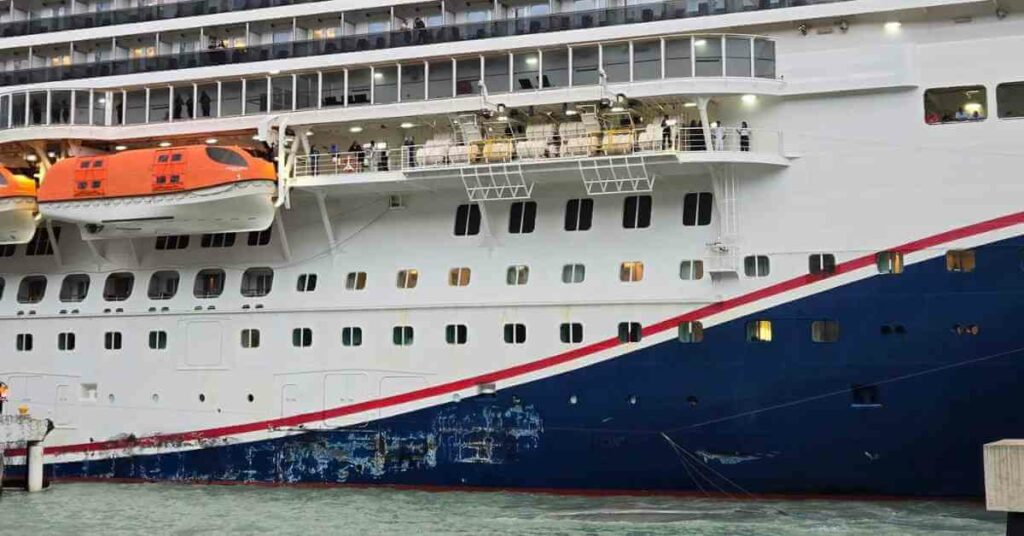Raw Video: Ship’s Lifeboat Drill Gone Terribly Wrong
They say, over the past few decades lifeboats have taken more lives than saved. Some even say lifeboat accidents have taken more lives than those taken by Somali pirates. After seeing the video, we bet you wouldn’t doubt these words.
Needless to say, most of the lifeboat accidents have been a result of human error or a snag in the mechanical system of lifeboats. But then, human error has many forms and most of them occur out of sheer negligence or laziness of the crew in following instructions and procedures. Moreover, mechanical failures in the lifeboat systems, design errors, insufficient training and drills, and complicated operating systems have also been the reason for lifeboat accidents.
Though the video mentioned here wasn’t fatal in any sense, it is similar to an another lifeboat accident which had 7 crew members inside the lifeboat, one of them lost his life while others were critically injured.
We believe after watching this video, mariners will understand how critical and important it is to take lifeboats and lifeboat drills seriously!
Don’t miss the end of the Video
What do you think went wrong here? Let us know in the comments below.
Note: We do not have any substantial information about the video or the accident. If you know more about the video, please let us know in the comments below.

About Author
Raunek Kantharia is a marine engineer turned maritime writer and entrepreneur. After a brief stint at the sea, he founded Marine Insight in 2010. Apart from managing Marine Insight, he also writes for a number of maritime magazines and websites.
Do you have info to share with us ? Suggest a correction
Latest Videos Articles You Would Like:
- Cruise Ship Damaged Due To Severe Weather, Passengers Stuck Abroad
- Archaeologists Examine 19th-Century Shipwreck Found On Canadian Coast
- Australia Stops Livestock Ship From Sailing Around Africa To Israel Amidst Houthi Attacks
- Iran Warns U.S. Of Targeting Cargo Ships Following Latest Airstrikes On Houthis
- Watch: Ukrainian Forces Destroy Russian Missile Boat In Black Sea Operation
- Two Dead After Tragic Collision Between Water Taxi And Passenger Ferry In the Philippines
Subscribe To Our Newsletters
By subscribing, you agree to our Privacy Policy and may receive occasional deal communications; you can unsubscribe anytime.
Web Stories






















limit switch failed to stop the winch. Thus the falls parted.
A person who operates has no idea about limit switch. You can see that he didn’t stopped hoisting until the lifeboat fall into the water. It is enough to presumed that the lifeboat is lack of maintenance and this was the first time they lowered the lifeboat for so many months thus, some of its automatic control device were no longer functioning caused by corrosion or cavitation.
This incident was reported in 2009 and is similar to a number I have analysed over the years.e
This was unconnected with limit switches and the falls did not break. The stern hook failed as is clearly seen at 1.07.
The hook was not properly set prior to lifting the lifeboat. On some boats it is not possible to positively identify where a hook is properly set.
As the lifeboat is brought inboard it stikes the stopper just below the davit arm which puts a sideways force on the improperly set hook, jogging it open.
Improper hooking prior to lifting is the root cause of the accident.
There is signs of slight rolling
Lessons to be learnt:
Strat hoisting only after getting an OK from the Bowman or the Stern sheet’s man.
Team leader and the winchman should be vigil. winchman or the team leader did not stop hoisting.
Only properly trained personnel should be deployed
The communication should be correctly in place.
Even before fall prevention device (FPD) was introduced it was a good practice to use a shackle with the boats eye and block after hoisting 1 meter above water level.
The problem with this is actually the lifting hook. This accident should not have happened if the cam pin of the lifting hook is secured and locked properly before stowing it back. Lack of extra safety precautions such as placing safety lashing from the floating block links to the maintenance pendant causes this problem too. I hope that this incident could be a case study for all seafarers so as to treat lifeboat with the upmost care.
Human errors and lack of understanding in the mechanical works of a lifeboat are the root causes for lifeboats accidents and fatalities.
Lifeboats are life saving equipments and not a life taking one.
STAY SAFE SEAFARERS!!!
The problem is the hook conection we have the same system and put in modefications
to the hook conection.
The problem is not the limit switch or the operator.
We testing the boats without people inside thes a life boats and not pleasure boats.
In case of you go inside because you have no choice.
And when we test the boat we lower it and go inside when the boat is lower.
Too many engineers standing around scrathing the arses, The hook system failed.
as far as i can tell no additional hooks were connected for testing, like wire lashings, i remeber when we were testing the quick release hooks from inside the boat, it was secured by additional wire lashings and only after the boat was completely in position and fastened did we discconect the wire lashings and left the boat secured only by the quick release hooks.
I would rather comment about the ‘suspension link’, than the limit switch or other things. What I can grasp from the footage is that the FWD link was broken and then the AFT one broke easily due to high dynamic forces. There can be several reasons why the link broke; e.g. corrosion, crack, material or weak design.
improper maintainance and negligience causes that mechanical era…everything should be secured properly and the crew/o.o.w. should have take a clear-cut watch while releasing life boat…so sad…life boats are life at sea, not to take life at sea…good day
Poor check up for maintainance of the hook that results to unexpected released and since it was a just a drill, FPD wasn’t attached…
It’s very common problem what happen on this lifeboat. Nothing to do with limit switch is the davit. When the make reset on the hooks theft hook didn’t reset correctly due to lack of maintenance so when the wire of the davit start become tight the hook open.
that’s why we ask all the time to maintained the hooks of the lifeboats and not only this parts.
Regards
Bill LSA Service Enginneer
Why wasn’t the FPD in place. Safety device which could have saved lives
What i see is that before securing a life boat it should be test first by pulling it up and put it down back with a sudden stop to know if the hock of the life boat is properly secured, second always look at the mark in the hook if it in possition coz sometimes its not in position.
When life boat hook was put on position when she was on off load the hydrostatic released unit was not in perfect position there is a marking you can see on fwd and aft hook colour indicates also green and red it was a mistake and they were hurry to pick up the boat because of these reason the boat came up and the suddenly tbe boat hook was released and the boat went down.To avoid these fall preventive device could have put to avoid accident
All personnel should have been of the boat at embarkation deck, and the lifting winch should have been reduced, to less power